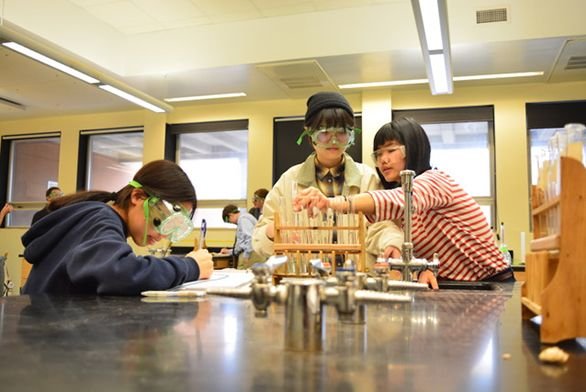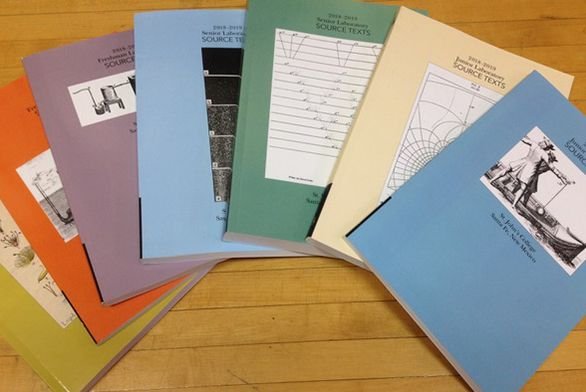Lab Manuals Get an Upgrade in Santa Fe
March 26, 2019 | By Eve Tolpa

For the first time since the St. John’s Program’s science curriculum was adopted some four decades ago, Santa Fe students’ source material is no longer compiled in comb-bound collections of photocopies. As of Fall 2018, the lab manuals have been available to students in the form of spine-bound softcover books.
These books are the culmination of work by a series of Santa Fe lab directors, says current director Eric Poppele (SF89), who took up the post in 2016 after 13 years as a tutor. It was his immediate predecessor, Bill Donohue (A67), who initiated the process of organizing and consolidating the written material used to teach the science portion of the Program.
“In the long-distant past, we just photocopied things,” Poppele says. “Making good-looking print materials is really easy to do. We began to realize we didn’t have a good excuse.”
As a former tutor and co-director/technical manager of Green Lion Press, Donohue was well-aware of the lab’s needs and of how to meet them. He began the process of digitizing and typesetting the articles, joined by Green Lion colleague and St. John’s tutor emeritus Howard Fisher, who helped make the material more consistently and legibly formatted. (The Annapolis campus manuals, says Poppele’s counterpart Mark Daly, are also consistently formatted and are spiral-bound.)
When he became lab director, Poppele decided to take the next step. He felt that “a good culmination of Bill’s work would be to put together all our source texts as books.” The resulting series—three books for freshman year and two each for junior and senior—are printed on demand, so they can be constantly refined and corrected for typos.
“Many of the [source books] are no longer in print,” says Poppele. “Some we have permission to use, some are public domain, some are translations done by tutors. The new books bring together texts that cover more than roughly 2,000 years’ worth of inquiry. These aren’t just historically interesting texts; they help us frame certain questions.”
Science, he emphasizes, isn’t just about keeping abreast of the latest, newest information. That information represents the discoveries of science, but science isn’t a collection of information. It is instead is an activity of inquiry.
“We read Aristotle in the laboratory not to contrast his views with modern science, but because he posed important questions that are still relevant to scientific inquiry,” says Poppele.

Because all St. John’s tutors teach all subjects, regardless of their formal academic backgrounds, the labs are occupied by a rotating cast of instructors who are helped by student assistants. Poppele’s position, however, is consistent.
“The lab community involves 20 different tutors and 20 different student assistants at once,” he says. “The lab director is responsible for making sure tutors and lab assistants have everything they need, from logistics and training to maintenance of equipment.”
In addition to formalizing the lab’s source material, Poppele has also been separating the tutor-written and tutor-provided supplemental material. The result is another text known simply as “the binder.” It comprises instructions for experiments (practica) and demonstrations; mathematical or theoretical concepts; and notes for readings, including a glossary.
“The [original] materials were comb-bound collections of 8.5 x 11 photocopies. The contents were a mixture of photocopies of books (the materials that are now in the source books) together with supplementary materials and instructions for experiments (what is now in the binder),” explains Poppele.
As the name suggests, it is literally a three-ring binder to which students are encouraged to add their own notes, graphs, and other documents. The binder is a work in progress with a format that mirrors the way Johnnies’ minds approach scientific topics—in open-ended inquiry.
Similarly, the new softcover books also reflect the higher purpose of their material.
“This, in some way, gives a special place of honor to the source authors,” Poppele says. “It’s a way to make sure we think of texts as something worth reading. These are great books—great texts—that deserve good treatment.”

